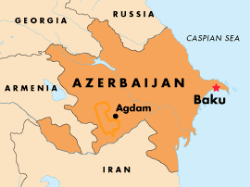Peter Semneby: I've been asked very often in the last few months whether I'm an optimist or a pessimist regarding Nagorno-Karabakh and relations between Armenia and Azerbaijan. I would say that I'm neither. I don't want to say that I'm an optimist, because so far it's always been the pessimists who have been proven right in this conflict. Still, one should always maintain hope, and I'm still hopeful that this conflict will be resolved soon. This is a very good moment for the region. It's a time when there are no major domestic considerations in the countries. It's also a time when the European Union is taking a much stronger interest in the region, something that is demonstrated by the inclusion of all of the Southern Caucasus countries into the European Neighborhood Policy.
RFE/RL: The International Crisis Group recently came out with a report urging the EU to be more engaged in conflict resolution in the region because it has the best leverage there, both financially and institutionally. Do you agree that the EU should put a priority on this issue?
Semneby: There is a lot that the European Union can do. The EU sent a political signal when it changed the mandate of the Special Representative, from a rather passive role in terms of conflict resolution to one where he is expected to contribute to conflict resolution. That change of wording may not change very much in practical terms, but it is an important political signal.
What is changing in practice are the resources and the instruments that the European Union has at its disposal. When the European Neighborhood Policy starts to take effect with the new financial perspective of the European Union in 2007, there will be considerable resources available for various activities, not least those related to conflict resolution and support of the development and rehabilitation of the conflict areas.
Already, at this stage, if there is a resolution, if there is an agreement between the parties, there are considerable rapid-reaction funds that the EU can also put at the disposal of the two governments of Armenia and Azerbaijan to repair what has been broken by the conflict.
RFE/RL: Nagorno-Karabakh isn't an easy conflict to resolve. Attempts so far have not been successful, and may continue to be unsuccessful for many years to come. Why has the EU decided that now is the time to become involved in conflict resolution?
Semneby : The reasons why the EU is more interested now than in the past has to do, of course, with the change of the environment in which we are living. The European Union is enlarging. Very soon it will have two members bordering on the Black Sea, Romania and Bulgaria. The EU has started to negotiate for membership with Turkey. That changes the perspective. What happens in the Southern Caucasus is no longer something abstract and distant. It is becoming an area of direct concern to the EU.
It's also an area that is important for energy resources. It's important because it's close to very volatile regions to the south. The Middle East, all the problems that we're facing with Iran also have focused attention on the Southern Caucasus. And it's also an important aspect of EU relations with our biggest and most important partner country in the East, and that is Russia.
RFE/RL: In the EU-Russia summit in Sochi on May 25, the Caucasus reportedly figured in the discussions. What specifically did you talk about? Do you find there are instances where Russia is heavy-handed in its policy on this area, and if so, do you express your concern?
Semneby: When the Caucasus is discussed with Russia, the three "frozen conflicts" that we have in the area are obviously high on the agenda. These conflicts -- in particular, the ones in Georgia -- are a direct issue in our relations with Russia.
What I hope and believe is that we will be able to resolve the two conflicts in Georgia together with Russia, because I fundamentally believe that it is in Russia's interests to have stable neighbors along all its borders and neighbors with which it maintains predictable and friendly relations. And only when the conflicts in Abkhazia and South Ossetia have been resolved once and for all will the problematic relationship between Russia and Georgia become normal.
RFE/RL: How much do you engage in dialogue with the South Caucasus governments on democracy issues? There are those in Azerbaijan, for example, who say that the EU and other Western powers aren't doing enough to remind the government of its commitment to promote democracy and respect human rights. How do you respond to such criticism?
Semneby: Fundamentally, we regard the countries in the South Caucasus as partners. And what you have to do with partners is you have to discuss the issues and you have to agree on what needs to be done. That takes some time, because our thinking has developed in different contexts, historically and otherwise.
Through an intensive relationship over the course of the last few years, I do think that we have come to a common understanding of what the standards are that need to be fulfilled. The proof of that is that we have in fact agreed more or less on quite extensive Action Plans to implement the European Neighborhood Policy, which includes the most important parts of the EU acquis [communitaire, the European Union's body of laws], in terms of democracy, human rights, rule of law, and so on. This is the first step. We will have the Action Plans very soon. I'm convinced that the last parts of the negotiations will be done very soon and they will be signed. That marks a new step in our relations, when the focus will be on the implementation of those Action Plans.
RFE/RL: The Council of Europe, for one, says Azerbaijan still has political prisoners -- a violation of Baku's international obligations. Some observers say the South Caucasus leaders are engaging with the West in order to stay in power, but aren't truly committed to democratic reforms. So what guarantee is there that these Action Plans will be signed?
Semneby: I think that the EU has proven in other cases that it does have a considerable transformational power, and I very strongly believe that through the carrots and sticks that the EU will have at its disposal as part of the Action Plans that there will be such a transformational power in the Southern Caucasus.
That is not to say it will be easy. We have seen many of the most difficult issues in other countries that have acceded to the European Union only being resolved at the very final stages.
This is an issue -- since we don't have a membership perspective in the European Neighborhood Policy, one of the most important carrots is not present. But I think there are still enough instruments of the same kind that have been very successfully applied in other countries in Central and Eastern Europe that can also be used in the South Caucasus.
The Nagorno-Karabakh Conflict
 Click on the image to view an enlarged map of the Nagorno-Karabakh conflict zone
Click on the image to view an enlarged map of the Nagorno-Karabakh conflict zone
In February 1988, the local assembly in Stepanakert, the local capital of the Azerbaijani region of NAGORNO-KARABAKH, passed a resolution calling for unification of the predominantly ethnic-Armenian region with Armenia. There were reports of violence against local Azeris, followed by attacks against Armenians in the Azerbaijani city of Sumgait. In 1991-92, Azerbaijani forces launched an offensive against separatist forces in Nagorno-Karabakh, but the Armenians counterattacked and by 1993-94 had seized almost all of the region, as well as vast areas around it. About 600,000 Azeris were displaced and as many as 25,000 people were killed before a Russian-brokered cease-fire was imposed in May 1994.
CHRONOLOGY: For an annotated timeline of the fighting around Nagorno-Karabakh in 1988-94 and the long search for a permanent settlement to the conflict, click here.
 Click on the icon to view images of the Nagorno-Karabakh conflict (Flash required)
Click on the icon to view images of the Nagorno-Karabakh conflict (Flash required)
To view an archive of all of RFE/RL's coverage of Nagorno-Karabakh, click here.



















